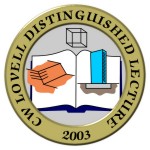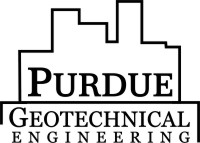
8th C.W. Lovell Distinguished Lecture
| - |
October 26, 2009

Dr. Delwyn G. Fredlund
Paradigm Shifts that Facilitate the Practice of Unsaturated Soil Mechanics
Soil Mechanics is considered to be a relatively young science extending back to the 1930s. The fundamental theories for Unsaturated Soil mechanics were developed and experimentally tested by the 1970s. Our practice of geotechnical engineering had undergone major changes by the time the theoretical context for Unsaturated Soil mechanics was formulated. In recent years there has been dramatic change related to the practice of unsaturated soil mechanics. Each of these changes can be likened to a paradigm shift. The paradigm shifts associated with implementation of unsaturated soil mechanics have been paralleled and even fueled by rapid developments in computing capabilities.
The digital computer proved to be a necessity for the implementation of Unsaturated Soil Mechanics because all physical processes for unsaturated soils were nonlinear. In many cases the nonlinear was extreme and produced convergence difficulties in numerical modeling. Each unsaturated soil process has been formulated in terms of a partial differential equation derived for a representative elemental volume. Unsaturated soil mechanics problems generally took on the form of boundary value problem. The primary challenge for implementation of unsaturated soil mechanics into engineering practice has centered on the ability to obtain a converged solution with the assurance that the converged solution was the correct solution. Consequently, unsaturated soil mechanics has been referred to as Nonlinear Soil Mechanics. Recent numerical solutions to unsaturated soils problems have taken advantage of techniques developed in mathematics and computing science. The most effective solution technique utilizes adaptive mesh refinement. Automatic mesh refinement alleviates most problems associated with nonlinearity. Convergence to the correct solution is now the responsibility of the mathematician.
This lecture divides the development of Soil mechanics into three eras; namely, the 1930 to 1960 era, the 1960 to 1990 era and the 1990 to 2000+ era. Each of these eras has associated with it a major paradigm shift in how the science of soil mechanics has been implemented into geotechnical engineering practice. Each of the paradigm shifts are described along with a suggested future road for the application of 21st century Saturated-Unsaturated Soil Mechanics.
About Delwyn G. Fredlund
| - |
Delwyn G. Fredlund has spent over 40 years conducting research into the behavior of unsaturated and expansive soils. Most of his career was spent at the University of Saskatchewan, Saskatoon, where he organized the Unsaturated Soils Group for research into all aspects of unsaturated soils behavior. His research studies have involved all areas of unsaturated soil behavior; ranging from the flow of water and air through unsaturated soils to the shear strength and volume change of unsaturated soils.
Del Fredlund is a native of Saskatchewan, Canada. In 1962 he obtained his B.Sc. degree from the University of Saskatchewan, Saskatoon. Immediately following his B.Sc. degree he went to work for the Division of Building Research of the National Research Council in Saskatoon, Sask. He then went on to obtain his M.Sc. degree in 1964 from the University of Alberta, Edmonton. Following his M.Sc. degree, he worked as a geotechnical consulting engineer for R.M. Hardy and Associates, Edmonton, Alberta.
In 1966 Del Fredlund accepted a position in the Department of Civil Engineering at the University of Saskatchewan, Saskatoon, Canada. In 1973 he obtained his Ph.D. after returning to the University of Alberta for his studies. Returning to the University of Saskatchewan, he developed a research program focused around the behavior of unsaturated soils and the numerical modeling of unsaturated soils problems. During his career he supervised over 65 M.Sc. and Ph.D. graduate students. He became the Head of the Department of Civil Engineering at the University of Saskatchewan from 1989 to 1994. He has also been appointed as an Adjunct Professor at Nanyang Technological University, Singapore and the Hong Kong University of Science and Technology, Hong Kong as well as at the University of Alberta, Edmonton. In addition, he is an Honorary Professor at the University of British Columbia, Vancouver, B.C. and a Research Professor at Arizona State University, Tempe, Arizona. He was appointed as an Honorary Professor at NHRI, Nanjing, China in 2005. He is also the K.P. Chao Chair at Zhejiang University, Hangzhou, China. Dr. Fredlund is presently a Senior Geotechnical Engineering Specialist with Golder Associates, Saskatoon, SK., Canada.
Throughout his career, Dr. Fredlund's research studies have focused on unsaturated soil mechanics and the behavior of unsaturated soils. The emphasis has been on studying the fundamental physical behavior of unsaturated soils as well as the numerical modeling of saturated-unsaturated soil systems. Significant contributions has been made in all the classic areas of unsaturated soil systems; including the stability of slopes, flow through saturated-unsaturated soil systems, and the prediction of heave in expansive soils.
He is the author, along with Dr. Harianto Rahardjo, of the book Soil Mechanics for Unsaturated Soils, published by John Wiley & Sons in 1993. This book still remains the key reference on unsaturated soil mechanics. The National Research Council of Canada published a book called, The Emergence of Unsaturated Soil Mechanics, which presented 63 key research papers by Del Fredlund on all aspects of unsaturated soil mechanics.
Dr. Fredlund published over 400 journal and conference research papers and has delivered many keynote lectures at conferences. He is the founder of Unsaturated Soil Technologies Ltd, Saskatoon, Canada, and is a designer of unsaturated soil testing equipment for GCTS in Tempe, Arizona. He is also a consultant to SoilVision Systems Ltd., a software company dedicated to the modeling of saturated-unsaturated soil systems. He presently heads the Golder Unsaturated Soils Group, assisting with the solution of unsaturated soil mechanics problems worldwide.
Dr. Fredlund has been the recipient of numerous awards such as the:
- Quigley Award, 2009, for the best paper published in the Canadian Geotechnical Journal in 2008.
- Julian Smith Award for lifelong contribution to the engineering profession in Canada, 2009.
- Zen Guo Xi Lecturer, 2007, Zhejiang University, Hangzhou, China.
- T.H. Wu Lecturer, 2007, Ohio State University.
- Order of Canada, 2004, from the Federal Government of Canada for his significant contribution to Canada and other countries around the world
- Commemorative Medal for the Centennial of Saskatchewan, 2005
- Terzaghi Award, 2005, given by the American Society for Civil Engineering
- Nominated to the Canadian Academy of Engineering, 2004
- CCPE, 2005, Canadian Council of Professional Engineers Award for Meritorious Service to the Engineering Profession
- Legget Award, 1999, from the Canadian Geotechnical Society.
- Award from the Brazilian Geotechnical Society for his great contribution to the technical, scientific and educational development of unsaturated soil mechanics
- Award from the Ministry of Science and Technology, MOSTE, Vietnam, for his contribution to scientific development in Vietnam.
- Kassiff Award from Israel
- Spencer Buchanan Award from Texas A & M, College Station, Texas.
- Stermac Award from Canadian Geotechnical Award
- Canadian Colloquium Award from Canadian Geotechnical Society.
Dr. Fredlund served as the Chairman of TC6 committee on Unsaturated Soils, of the ISSMGE for 12 years. He took early retirement from the University of Saskatchewan in 2000 in order to be able to fully devote his time to research into unsaturated soil behavior and the solution of practical geotechnical engineering problems in various parts of the world. His work on unsaturated soil mechanics has taken him to many countries of the world as a lecturer, a teacher and a consultant. He has undertaken international programs of collaboration with countries such as China, Africa and Vietnam. He is also a member of the Canadian Academy of Engineering.
During the past 12 years he has travelled to Vietnam several times each year as part of a technology exchange program between Canada and Vietnam. He has administered (along with Dr. Don Acton, College of Agriculture, University of Saskatchewan) a CIDA program on Land and Water Management in the Red River delta near Hanoi, Vietnam. During this time, he has become well-acquainted with the engineers and officials in the Government of Vietnam. He successfully completed the CIDA project in 1999. The project received the Nova Scotia Bank award for the best Research oriented CIDA project in 1997. He has conducted numerous Lectures and Short Courses in Vietnam over the past 12 years.
Dr. Fredlund is a member in numerous professional societies such as: the Canadian Geotechnical Society, the Engineering Institute of Canada, the American Society of Civil Engineering, and the International Society for Soil Mechanics and Geotechnical Engineering.
Presently, the primary focus of Dr. Fredlund's work involves bringing unsaturated soil mechanics into routine geotechnical engineering practice. Unsaturated soil mechanics has developed rapidly over the past few years and is quickly being implemented into routine geotechnical engineering practice. The most common example of the application of unsaturated soil mechanics involves the interaction between the soil and the climate imposed above the ground surface. The rainfall and evaporation from the ground surface produced a moisture flux boundary condition that often results in adverse performance of engineered structures such as highways and buildings. Dr. Del Fredlund has devoted his professional efforts towards meeting the needs associated with the furtherance and implementation of unsaturated soil mechanics into geotechnical engineering practice; both in Canada and around the world.
Program
| - |
| 4:30 p.m. | Lecture (LWSN 1142) |
| 6:00 p.m. | Reception and dinner (East Faculty Lounge, Purdue Memorial Union) (Reservations Required by Oct. 22 at 1:30 pm) |
Photos of 8th C.W. Lovell Distinguished Lecture
| - |


